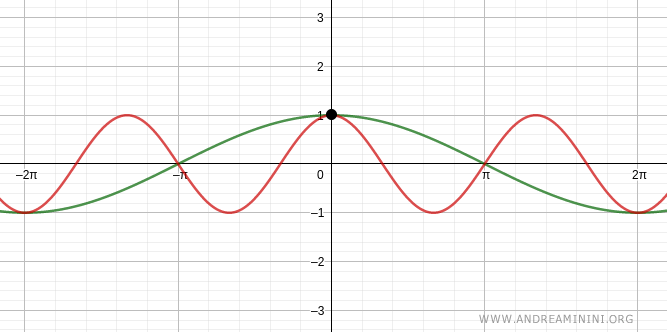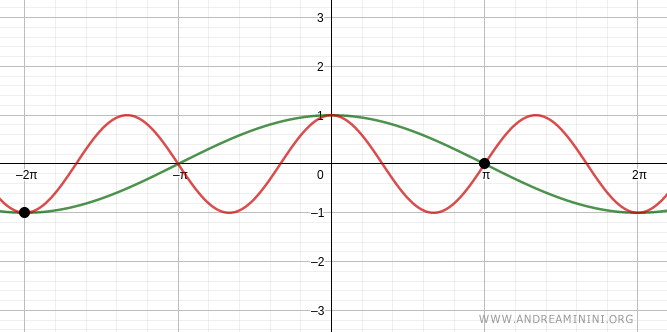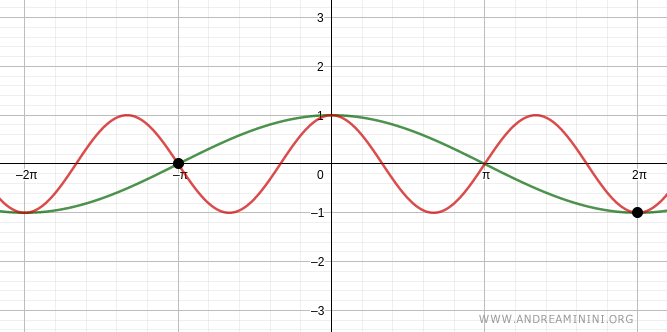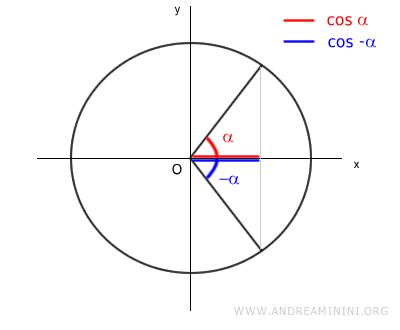Trigonometric Equation cos(a) = cos(b)
The trigonometric equation $$ \cos(\alpha) = \cos(\alpha') $$ holds true when the angles are either congruent, α=α', or opposites, α=-α'. Specifically, this results in $$ \alpha=\alpha'+2k \pi \ $$ or $$ \alpha = -\alpha' + 2k \pi $$
Because cosine is a periodic function with a period of 2π, this trigonometric equation has infinitely many solutions when we account for integer multiples k of a full rotation 2π.
Here, k is any integer within the range (-∞, ∞).
A Practical Example
Let’s solve the trigonometric equation:
$$ \cos\left(\frac{1}{2}x\right) = \cos\left(\frac{3}{2}x\right) $$
The angles in each cosine function are:
$$ \alpha_1 = \frac{1}{2}x $$
$$ \alpha_2 = \frac{3}{2}x $$
We use the trigonometric identity for cos x = cos y:
$$ \alpha = \alpha' + 2k \pi \ \text{or} \ \alpha = - \alpha' + 2k \pi $$
Substitute α and α':
$$ \frac{1}{2}x = \frac{3}{2}x + 2k \pi \ \text{or} \ \frac{1}{2}x = - \frac{3}{2}x + 2k \pi $$
We simplify to isolate x:
$$ \frac{1}{2}x - \frac{3}{2}x = 2k \pi \ \text{or} \ \frac{1}{2}x + \frac{3}{2}x = 2k \pi $$
$$ - x = 2k \pi \ \text{or} \ 2x = 2k \pi $$
$$ x = -2k \pi \ \text{or} \ x = k \pi $$
This gives all solutions for cos x = cos y by varying the integer k.
Verification for k = 0
$$ x = -2(0) \pi \ \text{or} \ x = (0) \pi $$
$$ x = 0 \ \text{or} \ x = 0 $$
A solution to the trigonometric equation is x=0.

Verification for k = 1
$$ x = -2(1) \pi \ \text{or} \ x = (1) \pi $$
$$ x = -2 \pi \ \text{or} \ x = \pi $$
Two additional solutions are x = -2π and x = π.

Verification for k = -1
$$ x = -2(-1) \pi \ \text{or} \ x = (-1) \pi $$
$$ x = 2 \pi \ \text{or} \ x = -\pi $$
Another pair of solutions is x = 2π and x = -π.

By varying k, we can obtain the infinite solutions to this trigonometric equation.
The Proof
Consider two angles, α1 and α2, that produce the same cosine value:
$$ \cos \alpha_1 = \cos \alpha_2 = c $$
Two angles have the same cosine value in two cases:
- when the angles are congruent (α1=α2)
- when the angles are opposites (α1=-α2)
Graphically, this appears as:

Thus, the conditions for equal cosine values are:
$$ \alpha_1 = \alpha_2 $$
$$ \alpha_1 = - \alpha_2 $$
Since cosine is a periodic function with a period of 2π, we also need to include integer multiples k of a full rotation, 2π, among the solutions.
$$ \alpha_1 = \alpha_2 + 2k \pi $$
$$ \alpha_1 = - \alpha_2 + 2k \pi $$
This completes the solution set for a trigonometric equation of the form cos α1 = cos α2:
$$ \alpha_1 = \alpha_2 + 2k \pi \ \text{or} \ \alpha_1 = - \alpha_2 + 2k \pi $$
And so on.
